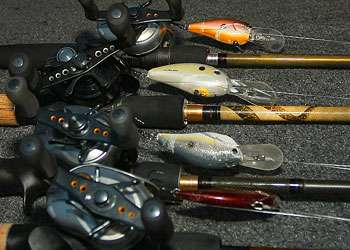
LAKE GUNTERSVILLE, Ala. — In four days of fishing here in the Southern Challenge, winner Aaron Martens never lost a crankbait, which says a lot about his ability to free snagged lures, but even more about the value that he placed on the crankbaits he was using.
Except for one smallish keeper that took a drop-shotted 4-inch worm, Martens won the $100,000 grand prize by cranking points and river ledges. His most productive lure was a Lucky Craft RC2.5DD in a pearl/chartreuse color variation that he teamed with a 6-foot, 9-inch Chimera Evolution baitcasting rod (medium action) by Megabass, an experimental reel with a 7:1 gear ratio and 20-pound-test Sunline Shooter Fluorocarbon line.
"The retrieve I used was critical to the number of bites I was getting," said Martens, who lives in Leeds, Ala. "I could catch bass with a slow, steady retrieve, but the most productive way for the bigger fish was to sweep the rod, then kill the bait for a second while winding up the slack."
Martens started out fishing shallow- and medium-diving crankbaits in practice on Monday, and caught dozens of bass, as did the rest of the field. On Tuesday morning, however, he found that different rip-pause-wind retrieve variations, fished over main-lake points and humps, yielded the heaviest bass for him. The erratic retrieve was the essential ingredient in his fishing approach all week, though the championship round was nerve-wracking for him as he failed to top 20 pounds for the first time in the tournament.
He blamed that more on the fact that he was sharing his spots with non-tournament anglers and "lost three or four places every day to local fishermen."
Martens had discovered bass on more than two dozen spots, however, and managed them well during the four-day Elite Series event. He finally wound up milking about 10 spots a day, all within a 15-mile radius of Lake Guntersville State Park.
"When they stopped pulling water Saturday, the sweeping retrieve triggered reaction strikes from bass that had gotten less aggressive," Martens said. "It was like I had to activate them again with that jerk-and-stop motion. Usually they would hit it just as it started up again. A slow, steady retrieve never produced as many strikes for me. As it was, I missed a lot more bass than I caught, but I blame that more on them not getting the lure good in their mouths."
How Martens worked a point or hump also was important. Typically, he took a point apart by casting parallel to either side, and then fishing the end by casting upriver and working the lure downcurrent. His best humps and bars in the main lake featured scattered milfoil at 4 to 8 feet deep. Here he would position his boat on the deeper side to work one or both ends of a spot at a time, depending on its length, then cast upriver from the downcurrent side, and finish by casting to the ends from the shallow-water side.
"Earlier in the week the bass were just stacked up in some spots," he said. "My best fish came from a hump that had grass around the edges and a opening in the middle. I would make 4 or 5 sweeps and then be in grass. The points were better when the current was running, earlier in the week, but I had to work for fish everywhere on Sunday."
Martens also gave credit to his Humminbird 1197 for helping him locate and waypoint his most productive areas.
"I looked for fish, I looked for rises and did a lot of graphing," he said. "Like I said, between the locals and me, my best spots got hammered and became worthless after the first couple of days. So I knew I needed a bunch of spots with shell-bed bottoms and scattered grass like I found on Tuesday. Thankfully, I had enough bass to last me, but it was getting close."
